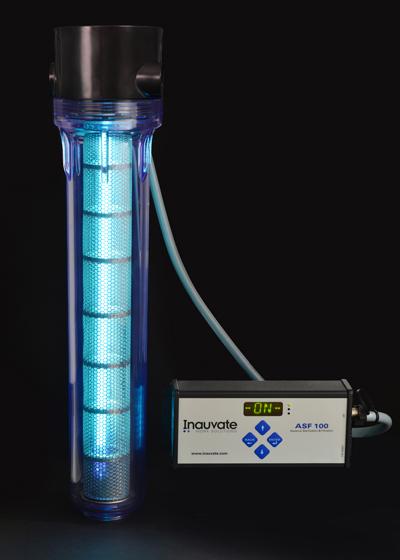
Inauvate Work Solutions introduces a novel, chemical-free UV light bacteria sterilization system designed to extend the life of machine tool coolant. Monday morning stink caused by excessive bacteria in machine tool coolant is a common problem in manufacturing. Inauvate has developed the chemical-free ASF 100 which combines an ultraviolet (UV) light with a customizable filter to control the spread of bacteria, mold and fungi while removing unwanted particles from aqueous industrial fluids. This prolongs fluid life leading to fewer change outs per year, lower disposal cost, and reduced machine downtime.
Inauvate's ASF 100 is compact, easy to install and made specifically for the manufacturing industry. It can be easily integrated into most machine tools that use aqueous liquids at temperatures of up to 125°F (51 degrees C) with tank volumes of up to 120 gallons. For applications with sump sizes over 120 gallons, multiple units can be installed in tandem to provide adequate disinfection. The ASF 100 can work in conjunction with portable oil removal equipment, such as skimmers and coalescers, for increased fluid cleanliness.
"Green" benefits of the ASF 100 include reduced waste, minimal energy costs, and a cleaner and healthier work environment. As a chemical-free system, it eliminates the need to use traditional harsh chemicals that can negatively affect performance of the work fluid, reducing cost and environmental waste. This is especially useful in heavily-regulated industries and locales, where common industrial chemical additives may be prohibited. A built-in safety interlock protects personnel from inadvertent exposure to UV radiation.
The ASF 100 relies on a multi-pass recirculating configuration and a directed flow through the filter unit to maximize UV exposure. Normal output models are ideally suited for use on aqueous parts washers and other systems utilizing transparent fluids. Opaque fluids, such as many metal-cutting coolants, do not transmit UVC waves as easily and thus require the use of a high-output UV disinfection model to be most effective. High-output models also include a bulb-monitoring feature to ensure that the UV bulb is lit which is ideal for applications where the opacity of the fluid prevents it from being checked visually. Sumps are available in a 10" size for compact installations and a 20" size for maximum light exposure and effectiveness.
The filter element helps to remove small chips from the coolant stream that can cause premature tool wear and degrade surface finish. It also protects the light surface from exposure to contaminants that can scratch its surface degrading performance of the UV system. Filters are made of stainless steel construction, allowing them to withstand harsh environments and multiple cleanings, and are available in standard 375, 540 and 840µm sizes with custom sizes available by special order.
Built-in electronics designed specifically for industrial environments allow for a variety of operation modes and visual alerts to the user when maintenance is required. A fully-programmable built-in timer allows the ASF 100 to be customized to fit any shop schedule and can act as a stand-alone unit with the capability to control an auxiliary pump. The ASF 100 can also be externally controlled, for example by a CNC machine using M code relays, with an optional I/O cable.
Sensors monitor the environment inside the filter unit and will adjust the output of the UV bulb to minimize particulate build-up and the resulting maintenance required to maintain the system's effectiveness. Visual notifications alert the user when common maintenance tasks such as filter cleaning, bulb cleaning, and bulb replacements must be performed.
Contact Details
Related Glossary Terms
- computer numerical control ( CNC)
computer numerical control ( CNC)
Microprocessor-based controller dedicated to a machine tool that permits the creation or modification of parts. Programmed numerical control activates the machine’s servos and spindle drives and controls the various machining operations. See DNC, direct numerical control; NC, numerical control.
- coolant
coolant
Fluid that reduces temperature buildup at the tool/workpiece interface during machining. Normally takes the form of a liquid such as soluble or chemical mixtures (semisynthetic, synthetic) but can be pressurized air or other gas. Because of water’s ability to absorb great quantities of heat, it is widely used as a coolant and vehicle for various cutting compounds, with the water-to-compound ratio varying with the machining task. See cutting fluid; semisynthetic cutting fluid; soluble-oil cutting fluid; synthetic cutting fluid.






